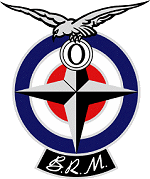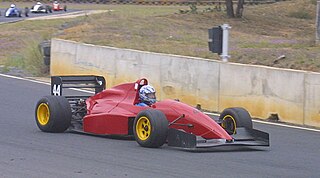
Stock car racing is a form of automobile racing found mainly and most prominently in the United States and Canada, with New Zealand, Australia, Mexico, Great Britain and Brazil also having forms of stock car auto racing. Traditionally, races are run on oval tracks measuring approximately 0.25 to 2.66 miles. The world's largest governing body for stock car racing is the American NASCAR, and its NASCAR Cup Series is the premier top level series of professional stock car racing. Top level races typically range between 200 to 600 miles in length. The cars were originally production models, but are now highly modified.

Sir Stirling Craufurd Moss, was a British Formula One racing driver. An inductee into the International Motorsports Hall of Fame, he won 212 of the 529 races he entered across several categories of competition and has been described as "the greatest driver never to win the World Championship". In a seven-year span between 1955 and 1961 Moss finished as championship runner-up four times and in third place the other three times.

Formula Three, also called Formula 3 or F3, is a third-tier class of open-wheel formula racing. The various championships held in Europe, Australia, South America and Asia form an important step for many prospective Formula One drivers. Formula Three has traditionally been regarded as the first major stepping stone for F1 hopefuls – it is typically the first point in a driver's career at which most drivers in the series are aiming at professional careers in racing rather than being amateurs and enthusiasts. F3 is not cheap, but is regarded as a key investment in a young driver's future career. Success in F3 can lead directly to a Formula 2 seat or even a Formula One test or race seat.

Formula One automobile racing has its roots in the European Grand Prix championships of the 1920s and 1930s, though the foundation of the modern Formula One began in 1946 with the Fédération Internationale de l'Automobile's (FIA) standardisation of rules, which was followed by a World Championship of Drivers in 1950.

British Racing Motors (BRM) was a British Formula One motor racing team. Founded in 1945 and based in the market town of Bourne in Lincolnshire, it participated from 1951 to 1977, competing in 197 grands prix and winning seventeen. BRM won the constructors' title in 1962 when its driver Graham Hill became world champion. In 1963, 1964, 1965 and 1971, BRM came second in the constructors' competition.
The 1966 Formula One season was the 20th season of FIA Formula One motor racing. It featured the 1966 World Championship of Drivers and the 1966 International Cup for F1 Manufacturers which were contested concurrently over a nine-race series that commenced on 22 May and ended on 23 October. The season also included a number of non-championship races for Formula One cars.
The 1965 Formula One season, which was the 19th season of FIA Formula One racing, featured the 16th World Championship of Drivers and the 8th International Cup for F1 Manufacturers. The two titles were contested concurrently over a ten-round series which commenced on 1 January and ended on 24 October. The season also included a number of non championship races for Formula One cars.
The 1959 Formula One season was the 13th season of FIA Formula One motor racing. It featured the 1959 World Championship of Drivers and the 1959 International Cup for F1 Manufacturers, contested concurrently over a nine race series which commenced on 10 May and ended on 12 December. The season also included a number of non-championship Formula One races.

The Coppa Acerbo was an automobile race held in Italy, named after Tito Acerbo, the brother of Giacomo Acerbo, a prominent fascist politician. Following Italy's defeat in World War II, and the consequent demise of fascism, the race was renamed the Circuito di Pescara, and in some years was also referred to as the Pescara Grand Prix and 12 Hours of Pescara. The race was run between 1924 and 1961 and over the years was held to a variety of vehicle class regulations and durations. In 1957 the Pescara Grand Prix formed a round of the Formula One World Championship, a race which still holds the record as having the longest circuit length ever used for a Championship event.

Roy Francesco Salvadori was a British racing driver and team manager. He was born in Dovercourt, Essex, to parents of Italian descent. He graduated to Formula One by 1952 and competed regularly until 1962 for a succession of teams including Cooper, Vanwall, BRM, Aston Martin and Connaught. Also a competitor in other formulae, he won the 1959 24 Heures du Mans in an Aston Martin with co-driver Carroll Shelby.

JBW Cars was a British racing car manufacturer in the late 1950s, who were a Formula One constructor from 1959 to 1961.
Reginald Harold Haslam Parnell was a racing driver and team manager from Derby, England. He participated in seven Formula One World Championship Grands Prix, achieving one podium, and scoring a total of nine championship points.

Formula 5000 was an open wheel, single seater auto-racing formula that ran in different series in various regions around the world from 1968 to 1982. It was originally intended as a low-cost series aimed at open-wheel racing cars that no longer fit into any particular formula. The '5000' denomination comes from the maximum 5.0 litre engine capacity allowed in the cars, although many cars ran with smaller engines. Manufacturers included McLaren, Eagle, March, Lola, Lotus, Elfin, Matich and Chevron.

Formula Holden was an Australian open wheel racing category introduced in 1989.

Oulton Park Circuit is a motor racing track close to the village of Little Budworth, Cheshire, England. It is about 5 miles (8 km) from Winsford, 13 miles (21 km) from Chester city centre, 8 miles (13 km) from Northwich and 17 miles (27 km) from Warrington, with a nearby rail connection along the Mid-Cheshire Line. It occupies much of the area which was previously known as the Oulton Estate. The racing circuit is owned and operated by Jonathan Palmer's MotorSport Vision organisation.

The Ferguson P99 was a four-wheel drive Formula One car built by Ferguson Research Ltd. for the Rob Walker Racing Team. It was the first AWD F1 car to race and used a 1.5-litre Climax engine. It remains the most famous example of its type as a result of its twin claims to fame: the first AWD car, and the last front-engined car to win a Formula 1 event.

Porsche has been successful in many branches of motorsport of which most have been in long distance races.

The Repco Brabham BT24 was a Formula One racing car design. It was one of three cars used by the Brabham racing team during their championship-winning 1967 Formula One season. Only three BT24 chassis were ever raced.

The Cooper T51 was a Formula One and Formula Two racing car designed by Owen Maddock and built by the Cooper Car Company for the 1959 Formula One season. The T51 earned a significant place in motor racing history when Jack Brabham drove the car to become the first driver to win the World Championship of Drivers with an engine mounted behind them, in 1959. The T51 was raced in several configurations by various entrants until 1963 and in all no less than 38 drivers were entered to drive T51s in Grand Prix races.

The FIA Formula 2 Championship is a second-tier single-seater racing championship organised by the Fédération Internationale de l'Automobile (FIA). The championship was introduced in 2017, following the rebranding of the long-term Formula One feeder series GP2.















